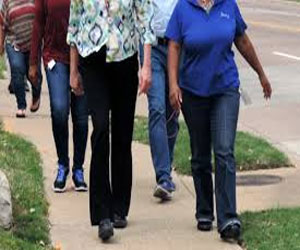- Home
- Editorial
- News
- Practice Guidelines
- Anesthesiology Guidelines
- Cancer Guidelines
- Cardiac Sciences Guidelines
- Critical Care Guidelines
- Dentistry Guidelines
- Dermatology Guidelines
- Diabetes and Endo Guidelines
- Diagnostics Guidelines
- ENT Guidelines
- Featured Practice Guidelines
- Gastroenterology Guidelines
- Geriatrics Guidelines
- Medicine Guidelines
- Nephrology Guidelines
- Neurosciences Guidelines
- Obs and Gynae Guidelines
- Ophthalmology Guidelines
- Orthopaedics Guidelines
- Paediatrics Guidelines
- Psychiatry Guidelines
- Pulmonology Guidelines
- Radiology Guidelines
- Surgery Guidelines
- Urology Guidelines
Thirty minutes of morning exercise lowers blood pressure for rest of the day in elderly

Thirty minutes of morning exercise lowers blood pressure for the rest of the day among the elderly who are overweight or obese, according to new research.n addition women who take brief, frequent breaks from sitting throughout the day can enhance the blood pressure benefits of morning exercise even more. The new research has been published in the American Heart Association's journal Hypertension.
"Traditionally, the health effects of exercise and sedentary behaviour have been studied separately. We conducted this study because we wanted to know whether there is a combined effect of these behaviours on blood pressure," said Michael Wheeler, lead author of the study at the Baker Heart and Diabetes Institute in Melbourne, Australia.
Researchers conducted the study to find out whether the beneficial effect of morning exercise on blood pressure was negated by long periods of sitting throughout the rest of the day in men and women, age 55 to 80, all of whom were overweight or obese, They also wanted to learn whether the benefit of morning exercise would be enhanced by taking frequent, short breaks from sitting.
Researchers had 67 participants (35 of whom were women) take part in three different scenarios, in a random order, separated by at least 6 days, in order to conduct the study.
uninterrupted sitting for 8 hours; one hour of sitting prior to 30 minutes of exercise, followed by 6.5 hours of prolonged sitting (exercise consisted of walking on a treadmill at moderate intensity); and one hour of sitting prior to 30 minutes of exercise, followed by sitting which was interrupted every 30 minutes with 3 minutes of light intensity walking for 6.5 hours. The study was conducted in a controlled laboratory environment, and the participants ate the same standardized meals the night before and during the study. Blood pressure and adrenaline levels were measured repeatedly during each 8-hour condition.
The researchers found that average blood pressure, especially systolic blood pressure, was reduced among both men and women who took part in morning exercise, compared to when they did not exercise. There was further benefit -- a significant reduction in average systolic blood pressure -- for women when they combined morning exercise with frequent breaks from sitting throughout the day. For men, there was no additional blood pressure benefit to taking frequent breaks from sitting.
Systolic blood pressure is the first of two numbers when blood pressure is taken. It measures pressure in blood vessels when your heart beats. Diastolic blood pressure is the second number, which measures pressure between beats. Wheeler says that over age 50, higher systolic blood pressure is more predictive of cardiovascular events than diastolic blood pressure.
The American Heart Association and American College of Cardiology hypertension guidelines define high blood pressure as 130/80 and above.
"For both men and women, the magnitude of reduction in average systolic blood pressure following exercise and breaks in a sitting approached what might be expected from antihypertensive medication in this population to reduce the risk of death from heart disease and stroke. However, this reduction was greater for women." said Wheeler.
The researchers do not know why there was a gender difference but think it may be a combination of factors, including varying adrenaline responses to exercise and the fact that all women in the study were post-menopausal -- a time when women are at increased risk for cardiovascular disease. Breaks in sitting have been shown in other studies to have a greater beneficial effect on blood pressure among groups with higher risk of cardiovascular disease, according to Wheeler.
The researchers conclude that the benefits of exercise on lowering blood pressure can be enhanced by avoiding prolonged periods of sitting and add that future studies should specifically test for gender differences in blood pressure with breaks in sitting alone.
"Having the study participants begin with exercise was intentional," according to Dr. Wheeler, "because we wanted to focus on the novel aspect of combining exercise with breaks in sitting. However, it means that we cannot say for sure that breaks in sitting alone had no blood pressure lowering effect in men, as any effect could have been masked by the preceding effect of exercise."
Future studies would be needed to see if the same benefits would apply to younger people and those who are not overweight. But, according to Wheeler, "As the proportion of those who are overweight with higher blood pressure increases with age, adopting a strategy of combining exercise with breaks in sitting may be important to control and prevent the development of high blood pressure."

Disclaimer: This site is primarily intended for healthcare professionals. Any content/information on this website does not replace the advice of medical and/or health professionals and should not be construed as medical/diagnostic advice/endorsement or prescription. Use of this site is subject to our terms of use, privacy policy, advertisement policy. © 2020 Minerva Medical Treatment Pvt Ltd